A turbo for company growth and a huge potential for partnerships and strategic cooperations: Federal Procurement has concluded a framework agreement with Consileon for a potential contract volume totalling 683 million euros to implement digitisation projects for public institutions in Austria – from ministries to fire brigades to universities of applied sciences.
In August 2022, the Bundesbeschaffung GmbH (BBG) (eng.Austrian Federal Procurement) concluded large-volume framework agreements with Consileon Business Consultancy GmbH as part of its “IT Services 2022” tender. These are the basic prerequisite for processing orders from the public sector.
The total volume of these framework agreements – put out to tender by the BBG in individual lots – amounts to 778 million euros for the next five years.
Consileon’s clients – and thus future customers – are institutions, facilities and authorities from the entire public sector. These include ministries, energy suppliers, public logistics companies, hospitals, fire brigades, kindergartens, technical colleges and many more. A total of 2564 accounts and organisations are involved!
Consileon prevailed in 17 of 20 lots offered and was thus awarded a total volume of 683 million euros – together with four competitors per lot.
In concrete terms, Consileon now has the opportunity to make a significant contribution to Austria’s digital development in the following areas:
“In addition to the framework agreements won in 2021 in the areas of artificial intelligence, Java services, cybersecurity, software and testing services, Consileon now covers the entire range of IT fields and topics,” says Harald Kohlberger, Managing Partner of Consileon Business Consultancy in Austria, and adds: “The field is primed for a strong increase in business growth for Consileon in Austria. We want to deepen existing partnerships, establish new strategic cooperations and, in any case, massively expand the structures on the Austrian market to realise this enormously high sales potential.
To this end, we actively invite you to cooperate with us! We are very much looking forward to exciting conversations, new considerations and ideas from applicants and implementation partners!”
Consileon’s clients in the core markets of the DACH region (Germany, Austria and Switzerland) benefit from its many years of experience in the planning, application and implementation of new IT. In addition, the consulting firm with its approximately 500 employees also accompanies the cultural change that accompanies every digital transformation. The current annual turnover is € 76.5 million euros, making Consileon number 17 in the current Lünendonk ranking of medium-sized IT consultants & service providers.
Designing, initiating and implementing – that’s where Consileon is strong.
Hooray! This calls for a celebration: Consileon took top places in two performance categories in this year’s “Best IT Service Providers 2023” ranking. In the areas of “IT Consulting” and “Software Implementation & Maintenance”, the Karlsruhe-based consulting company was explicitly recommended by customers and industry experts.
Between April and June 2022, Brand eins, a renowned German business magazine, and the statistics portal Statista surveyed a total of 5107 IT experts, industry insiders and users to find out which IT service providers they had had good experiences with and who they would recommend. This resulted in this year’s best list of 286 IT service providers across Germany, ranging from small regional providers to large corporations. The awards are now being presented for the fourth time.
“We are proud and grateful to be among the best IT service providers in Germany,” says Dr. Joachim Schü, owner and managing director of Consileon Business Consultancy. “This survey of industry experts and users provides important guidance for anyone looking for particularly reliable IT partners. The award is also an incentive for us to continue to keep our quality standards high in order to live up to the trust and appreciation of our customers.”
Another Consileon Group company can also look forward to a place on the best list of brand eins and Statista for the first time this year. The consulting experts for sales, service and marketing from ajco solutions GmbH are also recommended for their excellent performance in the field of “IT consulting”.
Further information and the complete ranking “Best IT Service Provider 2023” can be found on the brand eins website.
Overview of other awards from Consileon Business Consultancy:
• brand eins award “Beste Unternehmensberater 2022″
• Consileon among the top 20 IT consulting companies “Lünendonk Liste 2022”
• Handelsblatt award: The Top Consultants 2022
You have the feeling that your company should actually have significantly more output? The time-to-market is far too long? Your products are always behind schedule or have quality problems? Sounds like there’s sand in the gears somewhere. Sounds like a bottleneck.
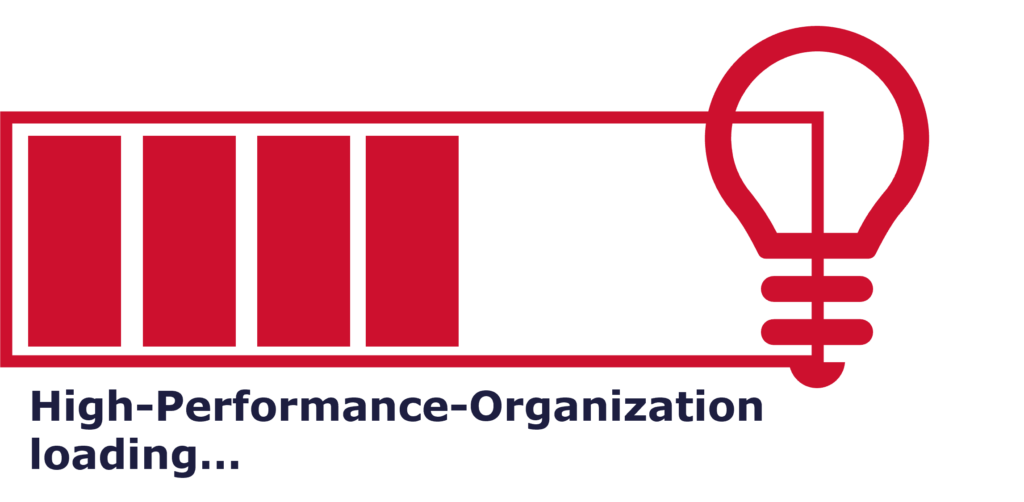
Wolfram Müller, our expert for high-performance organizations, knows how to find and resolve your bottleneck. Why is it worthwhile for CEOs to deal with this topic? The list of benefits clearly speaks for itself:
If the output of a company is not right or processes and projects simply take too long, it is usually due to a bottleneck. To relieve and resolve it, we first need to know where it is in the first place. This small checklist helps to find the bottleneck.
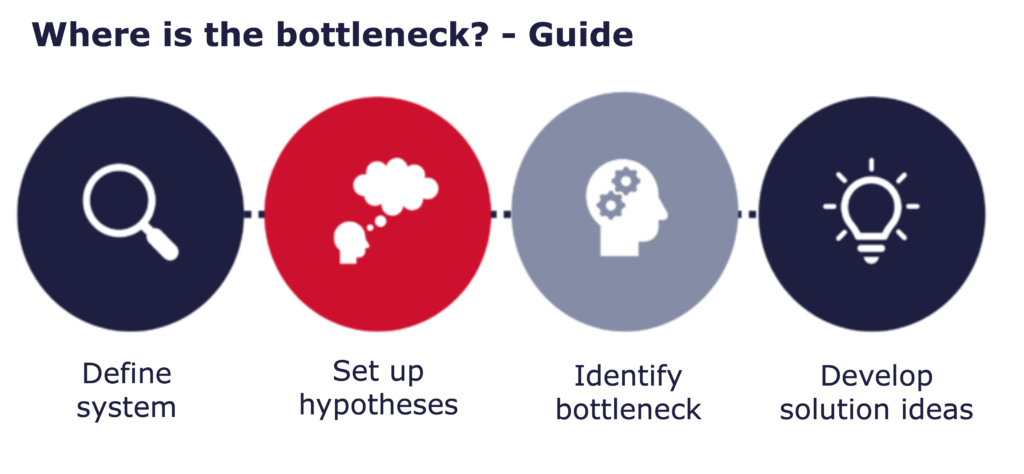
Cyber security expert, Jan Oetting, suspects that one pillar of critical infrastructure in particular is at risk: communications and media. He explains here why we should protect this area particularly well against hacker attacks.
There is much speculation at present about attacks on our critical infrastructure. There is fear that water supplies and power plants could be tampered with. “Of course, cyber shields should be up everywhere, IT staff everywhere need to monitor their IT systems for typical attack patterns,” says IT specialist Jan Oetting. “But the question is, what good would it do Putin if a power grid was shut down for a few hours? The damage would only be temporary and would probably have no long-term effects. But what Putin is really interested in is presenting his view of things.”
Already today, we receive very different figures from the Ukrainian and Russian sides regarding the dead and injured. Independent authorities can neither verify nor confirm one or the other figure. It is obvious that each side uses its data to generate emotions – one to morally support the Ukrainian resistance, the other to emphasize its success in military operations.
“Putin” and “Selenskyj” both regularly occupy the top ranks in Twitter trends and search queries. But on the social media front, Ukrainian President Volodymyr Selenskyj is clearly ahead. His little cell phone videos and messages in Ukrainian, English and Russian are liked and shared millions of times on Twitter and Facebook. The Western media disseminate and interpret them on a daily basis. The politician benefits from his training as an actor and his affinity for the media, among other things. He has a gift for packaging messages in short, emotional words. That leaves a big impression on people.
In contrast, Vladimir Putin looks rather unspectacular. An older, pale man with small eyes and a bloated face. Support among the Russian population is waning. More and more people in Russia are taking to the streets to demonstrate for peace, despite the threat of fines and imprisonment. More and more young Russian men are deserting or trying to leave the country to avoid being drafted by the military… Putin’s sentences are harsh and awkwardly worded. He seems to lack the social media ease of his opponent. The whole world hangs on Selenskyj’s every word, but Putin doesn’t like to listen. That probably annoys him quite a bit…
The war against Ukraine began back in January with hacker attacks on Ukrainian government websites. Cyberattacks have therefore long been seen as a component of modern warfare. The tough economic sanctions recently imposed on Russia by the Western world could provoke the Russians to engage in cyber warfare. As a result, countries are currently arming themselves at full speed against any hacking attacks. In Germany, all cyber security measures converge at the National Cyber Defense Center in Bonn. The main aim is to protect critical infrastructure – including the energy sector and the financial sector – from attacks.
Cyber security expert Jan Oetting is currently a highly sought-after media expert (including ARD-Börsenstudio, Schweizer Rundfunk, Der Spiegel). He suspects that large-scale and long-planned virtual heists could shake the international financial system.
We spoke with him about the consequence and effectiveness of sanctions and potential cyber threats.
Today’s working world is characterized by constant progress. Who doesn’t know it – the smartphone rings non-stop, the number of e-mails in the inbox increases, one appointment follows the next and you are almost permanently available. Digitization in particular increases the pressure to perform and to continuously adapt to changes. Especially when a heavy workload rests on one’s shoulders, physical warning signals are often ignored. You’re probably wondering why this is a men’s health issue. Simply because men are affected differently here by common stereotypes than women, who struggle with stereotypes of their own. Here in this article, we want to focus on men’s health and intentionally create visibility that way.
The availability of drugs for cognitive performance enhancement is particularly tempting nowadays due to the low-threshold procurement structure. However, such drugs are often associated with side effects such as cardiac arrhythmias, anxiety and addiction. In addition, it is becoming increasingly challenging to find a balance between artificially generated productivity and regeneration. In order to achieve phases of recovery, the existing tension must first be relieved, with many sufferers turning to alcohol, hashish or other sedatives to speed up the process.
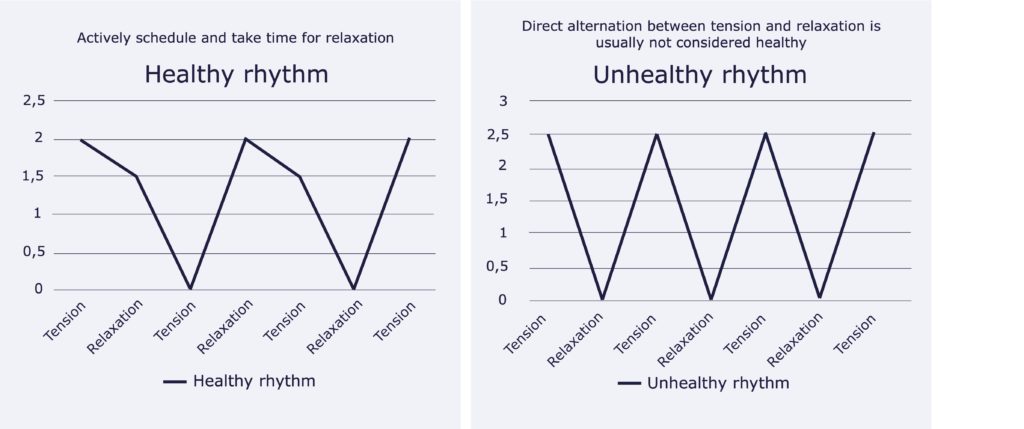
By skipping a conscious upstream relaxation phase, there is a danger that a real recovery cannot take place. The result is often a very high level of psychological stress, burnout, or even resorting to appropriate preparations in order to relax or recover more quickly. The after-work beer to come down is only one example of this, which is socially recognized. The danger here lies not in the one beer, but in the toxic cycle and a lack of healthy coping strategies. It is therefore important to be aware of one’s own behavior patterns, to reinforce healthy aspects (e.g., sports, community, art) and to avoid negative methods (e.g., addiction, substance abuse). The goal is to proactively respond to individual circumstances and consciously work on both external and internal factors – always focusing on one’s own health.
Reflection questions at the point may be:
Although our health care system is geared toward cis men (men who were assigned the male sex at birth), for many health plays only a subordinate role. They often ignore physical and mental warning signs, and on average, men die five years earlier than women. With the help of the Movember initiative, information and attention are to be generated every year in November around the topic of men’s health.
We at Consileon had decided to support this issue both financially and through visibility work, as we are directly affected by our demanding work environment and the pressure that comes with it. In the consulting industry, 60-70 hour weeks are normal and so is the fact that employees do not stay with the company for more than two to three years. We are actively trying to live this differently, with a focus on the health of our employees. In concrete terms, this means paying attention to working hours and constantly establishing measures to ensure that employees feel good in the long term. We are also still in a learning phase here and had Jacob Drachenberg, among others, as a speaker at one of our last company events. A large number of employees went through his health program afterwards.
The donations collected from our Movember campaign will benefit the project “Against dangerous brain doping” of the Men’s Health Foundation. This “wants to help those affected, their relatives, friends and colleagues and provide them with information. Two guidebooks on the abuse of performance-enhancing drugs and harmful alcohol consumption are to be written, aimed primarily at men. Like all the Foundation’s guidebooks, they are compact, easy to understand, factual and written according to the latest findings. They can be downloaded free of charge from our website. With the booklets, we hope to bring the topic to the attention of the general public and to awaken those affected. With the booklets, we also want to give those responsible for workplace health promotion an instrument that they can use to talk to affected employees. Homepage, Men’s Health Foundation
We would like to take this opportunity to thank all donors, all those who took part in the campaigns and our management, which topped up the amount once again.
The United Nations’ Agenda 2030, the Paris Climate Agreement, the European Union’s Green Deal – in order to counter global warming, world politics is setting the course for a society with an economic model that is more strongly oriented toward criteria such as environment, social, and governance (ESG). Sustainability is thus also becoming increasingly important for the financial sector.
But what is the current status of the industry in terms of sustainability and what potential is perceived? Together with syracom, we interviewed experts from the financial industry, most of whom work for small and medium-sized enterprises. The questions asked included: How is the industry positioned in terms of sustainable product offerings and in which areas is there a need for action? Where in the own organization are most sustainability activities perceived? How far along are IT strategic considerations? How will the upcoming regulatory requirements of the EU taxonomy at the turn of the year 2021/2022 affect the industry?
We answer all this and much more in our study. Enclosed you will find a short reading sample of our study, from the Geldinstitute issue 03/2021 dated 10.12.2021.
Our full study will be available in January 2022. You are welcome to pre-order the study here.
(The study is in German.)
In the following, you will gain a brief insight into Consileon’s Smart Mobility Study 2021. This study examines the situation in a sample of 92 medium-sized and large German cities with regard to the connectivity and sustainability of transport and smart mobility.
Unlike existing studies, which increasingly focus on the smart city of tomorrow, we are analyzing the topic of smart mobility in particular. Although cities cover only two percent of the global land area, half of humanity lives in them. As the influx into metropolises continues, they must become smarter. Despite car sharing, public transportation and the bicycle boom, car density in Germany is steadily increasing. There are currently 574 cars per 1,000 inhabitants.
One approach to alleviating this environmental and space problem with modern technology is smart mobility. It is realized by upgrading the transportation infrastructure with information and communication technology. Mobility apps and websites collect data from sources such as traffic guidance systems, timetables, crowd projects, cameras or sensors on vehicles, traffic lights, parking lots or roads. Find out from us which cities perform particularly well in which categories or in which areas there is still potential for optimization.
Feel free to contact us with suggestions and feedback!
You can order our Smart Mobility Study 2021 here. If you have any further questions, please contact us here.
(The study is in German)
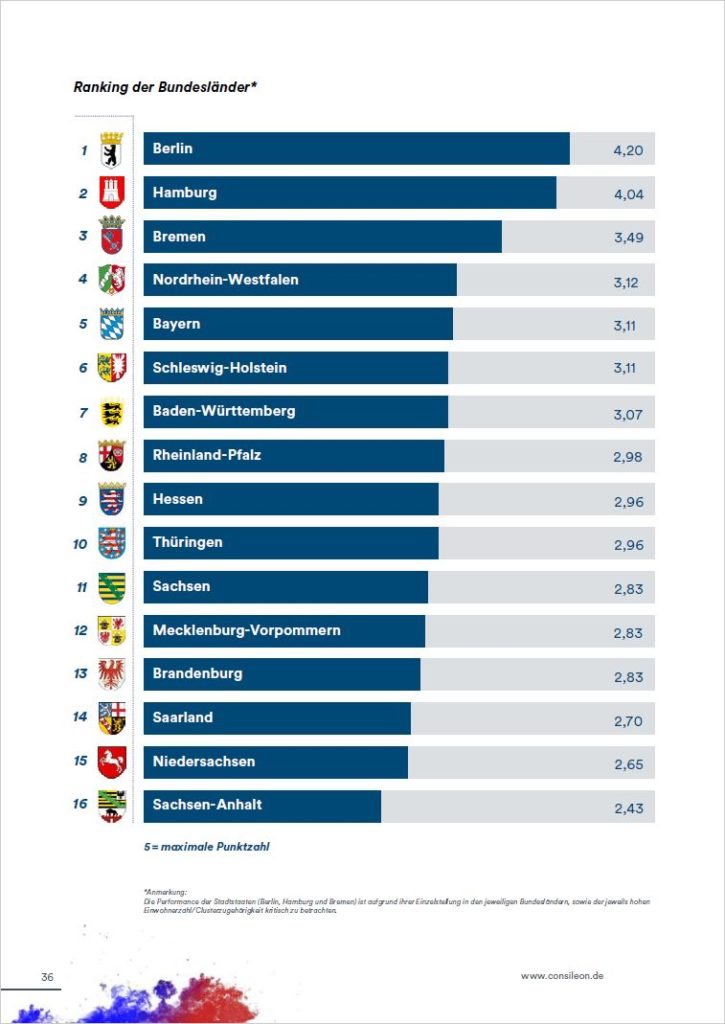
Co-creation is the concerted interaction of project parties (stakeholders) in the development of business models, processes or products. One co-creative approach is design thinking. Its goal is to design the optimal solution from the customer’s or user’s point of view in an interdisciplinary and iterative manner. From trend analyses, surveys, role plays, and collaboration with natural or institutional opinion leaders or trendsetters, also known as lead users in product development, the project team derives one or more fictitious sample users (persona), for whom it constructs, tests, and develops a prototype to readiness for use. After each stage, the team obtains feedback from the client and the users.
If you develop products without taking into account the customers’ wishes, you waste time and money. To make sure that a product idea or a solution approach meets the needs of all user groups, it is essential to consult with expert representatives again and again throughout the development process. Ideally, constructive cooperation between the project parties will uncover previously unrecognized problems or produce long-sought niche solutions. The prime example of such synergy effects is the cooperation between electricity providers, car manufacturers and municipalities in the development of electric mobility suitable for everyday use.
The innovation process follows a step-by-step plan (Fig. 1). It is essential to complete the work at the current stage before moving on to the next. If the developers encounter unexpected hurdles, assumptions turn out to be wrong or the result fails to meet the specifications, the team continues to work on the stage in question until everything fits.
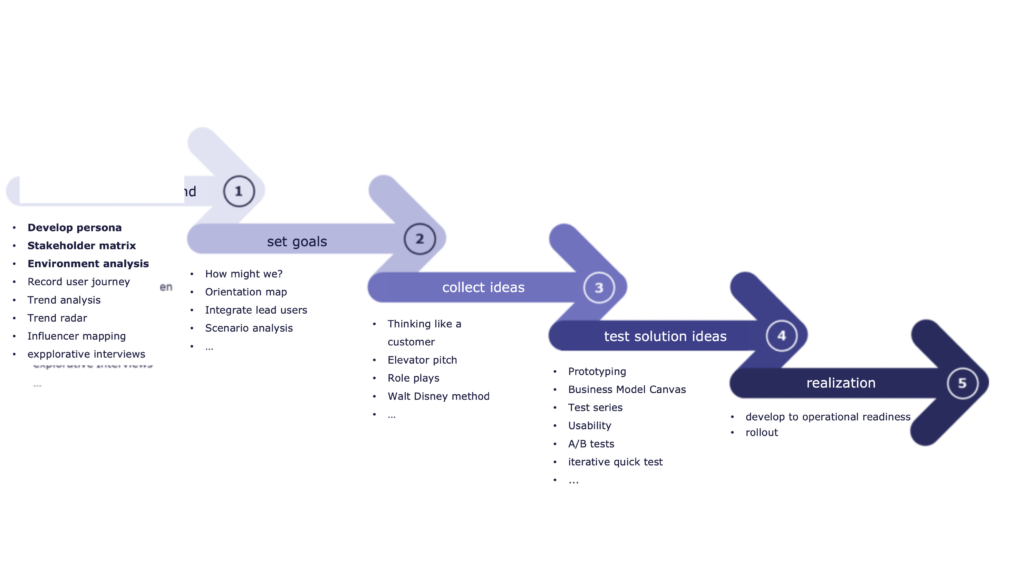
The innovation process begins with eliciting and understanding the need. What problem does the client or user have to solve? What motivates him to buy or use the product? The following methods and tools help in this process.
By combining demographic characteristics such as age, gender, occupation, income, education or hobbies, the project team defines one or more fictitious sample users, so-called personas, at stage 1 of the innovation process. The team determines which characteristics of the persona are relevant for the product and to what extent by observing and interviewing them. Instead of classic user roles with few dimensions such as student, entrepreneur or mother, it develops the product for differentiated, imaginary individuals. By giving each persona a name and fictitious resume, developers find it easier to empathize with the persona’s interests and design the product from their perspective. Persona development takes a few hours.
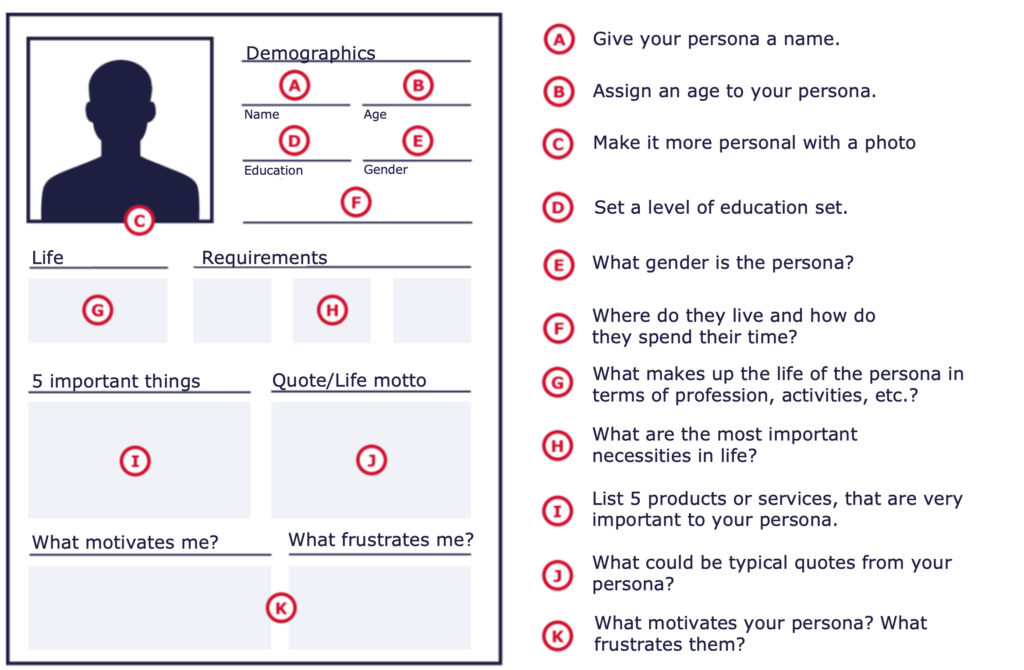
After identifying the target groups and their wishes, developers analyze all project parties (stakeholders), their interests and any interdependencies. The following questions help in this process:
Environmental analysis is the recording, investigation, evaluation and documentation of external influences on a project. It precedes project planning in the narrower sense. The environment analysis records and documents, among other things:
A stakeholder matrix (Fig. 3) visualizes the relationship of each project party to the problem or its solution. This gives developers an overview of acute or latent conflicts of interest.
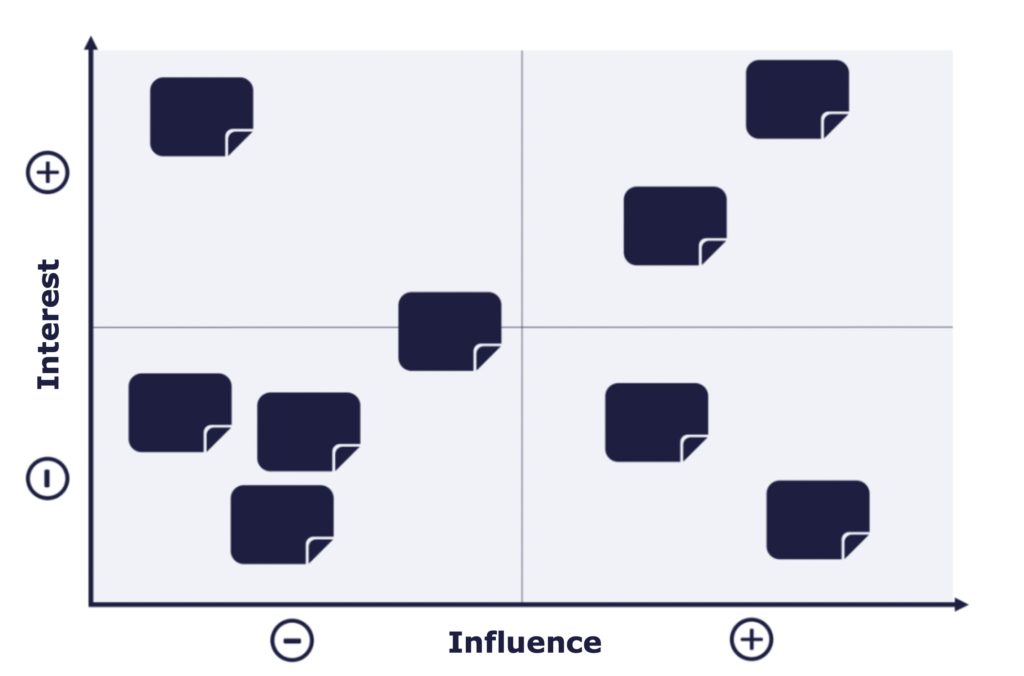
The spectrum of methods for researching the interests and wishes of target groups such as customers, users, and citizens ranges from recording the customer or user journey to trend analyses and explorative interviews. The user journey is a flow chart of a user’s interaction with software or another product. It provides information about what the user expects from the product, how well the interaction works, where there are problems, and what could be improved.
Trend analyses help to assess the evolution of a business model’s environment. What will drive customers, consumers, and voters in the coming months or years? How is the economy doing? Where is technological progress headed? How will politics react? The answers to questions like these are incorporated into a trend radar that visualizes the opportunities and risks of a business model (Fig. 4).
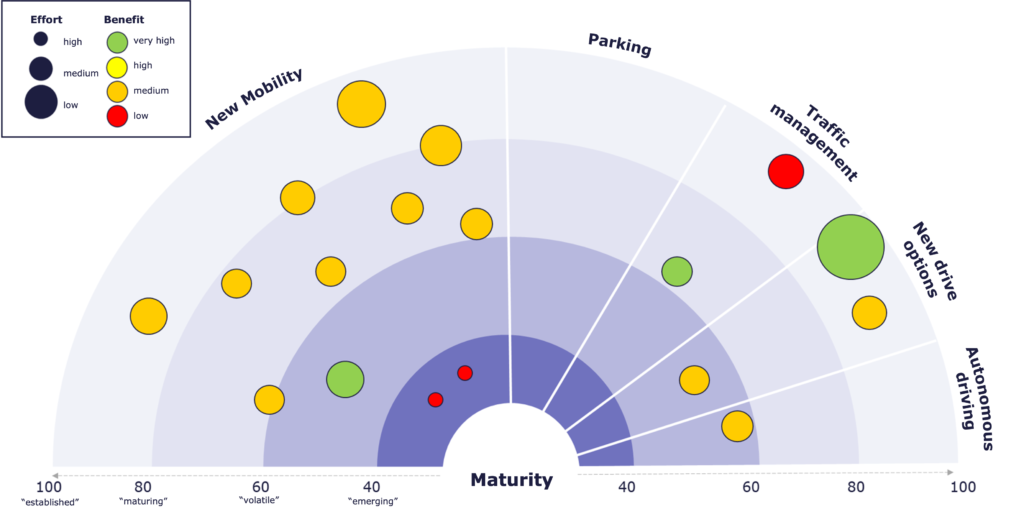
From the analysis of the initial situation, the opportunities and risks, the project team formulates its goal in the second stage of the innovation process. This is where methods such as “How might we? (HMW, roughly: “How might we achieve X?”) or so-called orientation maps come into play. HMW is about mobilizing the creativity of the participants with concrete but open questions about core elements of the project goal or the planned product. HMW questions are also called focus questions.
The orientation map (orientation matrix) outlines the project’s or product’s scope of possibilities. It shows the fields of action in which operational or technical innovations such as digitization will create sustainable value. Scenario analyses and exchanges with lead users help to define this space.
Design thinking has proven its worth for developing and collecting solution approaches or product ideas. Design thinkers approach the expectations and interests of target groups in an interdisciplinary and iterative manner. The resulting ideas are systematized, evaluated and concretized through further research.
The elevator pitch reduces an idea to its core and the most important steps for realization. The presentation should be so concise and clear that it could be conveyed to an outsider during the duration of an elevator ride. A form helps you to formulate it. In it, you record the “pitch” for reuse and optimize it iteratively based on the feedback from your discussion partners.
The project team invites real stakeholders to take part in role plays. For example, to reflect the interests of a city, citizens from various demographic groups are needed, as well as representatives of the local authorities and private service providers.
From the feasible solution approaches, the project team selects the one that meets with the broadest approval among the project parties. Now it must be shown how this approach proves itself in practice. To do this, the team first develops a prototype. If the representatives of the target groups accept it, the project owner negotiates further steps in parallel with the development, such as cooperative ventures for expansion or scaling. If the prototype fails, the stage is repeated with the next best approach until a viable solution is found.
A popular tool for analyzing, improving and further developing a project or product idea is the “Business Model Canvas” (BMC), a tabular template for the condensed presentation of a business model. The “canvas” provides a framework of nine headings, each of which describes a core element of the business idea – from customer benefits and the targeted market segments to costs and revenues. Based on target questions, the team fills in the nine headings in keywords. This gives them an overview of the project’s or product’s chances of success and the interdependence of the success factors.
Once the team has decided on a business idea or a design concept, it presents it to representatives of the target groups, analyzes their response and collects suggestions for improvement. Suitable methods include usability tests, A/B tests or rapid iterative testing & evaluation (RITE), focus groups, expert interviews or online surveys. If the idea or design passes the series of tests, the team works it up to deployment or market maturity.
The innovation process ends with clarification of the financing of live operation or series production and the integration of the solution into the current business model. Checklists help to report on the realization and to track the market entry or live operation.